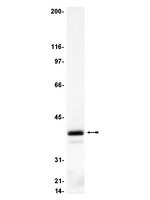Subcellular localization of LGN during mitosis: evidence for its cortical localization in mitotic cell culture systems and its requirement for normal cell cycle progression.
Kaushik, R; Yu, F; Chia, W; Yang, X; Bahri, S
Molecular biology of the cell
14
3144-55
2003
概要を表示する
Mammalian LGN/AGS3 proteins and their Drosophila Pins orthologue are cytoplasmic regulators of G-protein signaling. In Drosophila, Pins localizes to the lateral cortex of polarized epithelial cells and to the apical cortex of neuroblasts where it plays important roles in their asymmetric division. Using overexpression studies in different cell line systems, we demonstrate here that, like Drosophila Pins, LGN can exhibit enriched localization at the cell cortex, depending on the cell cycle and the culture system used. We find that in WISH, PC12, and NRK but not COS cells, LGN is largely directed to the cell cortex during mitosis. Overexpression of truncated protein domains further identified the Galpha-binding C-terminal portion of LGN as a sufficient domain for cortical localization in cell culture. In mitotic COS cells that normally do not exhibit cortical LGN localization, LGN is redirected to the cell cortex upon overexpression of Galpha subunits of heterotrimeric G-proteins. The results also show that the cortical localization of LGN is dependent on microfilaments and that interfering with LGN function in cultured cell lines causes early disruption to cell cycle progression. 記事全文 | | 12925752
 |
G(o)-protein alpha-subunits activate mitogen-activated protein kinase via a novel protein kinase C-dependent mechanism.
van Biesen, T, et al.
J. Biol. Chem., 271: 1266-9 (1996)
1996
概要を表示する
Mitogen-activated protein kinase (MAPK) is activated in response to both receptor tyrosine kinases and G-protein-coupled receptors. Recently, Gi-coupled receptors, such as the alpha 2A adrenergic receptor, were shown to mediate Ras-dependent MAPK activation via a pathway requiring G-protein beta gamma subunits (G beta gamma) and many of the same intermediates involved in receptor tyrosine kinase signaling. In contrast, Gq-coupled receptors, such as the M1 muscarinic acetylcholine receptor (M1AChR), activate MAPK via a pathway that is Ras-independent but requires the activity of protein kinase C (PKC). Here we show that, in Chinese hamster ovary cells, the M1AChR and platelet-activating factor receptor (PAFR) mediate MAPK activation via the alpha-subunit of the G(o) protein. G(o)-mediated MAPK activation was sensitive to treatment with pertussis toxin but insensitive to inhibition by a G beta gamma-sequestering peptide (beta ARK1ct). M1AChR and PAFR catalyzed G(o) alpha-subunit GTP exchange, and MAPK activation could be partially rescued by a pertussis toxin-insensitive mutant of G(o) alpha but not by similar mutants of Gi. G(o)-mediated MAPK activation was insensitive to inhibition by a dominant negative mutant of Ras (N17Ras) but was completely blocked by cellular depletion of PKC. Thus, M1AChR and PAFR, which have previously been shown to couple to Gq, are also coupled to G(o) to activate a novel PKC-dependent mitogenic signaling pathway. | Immunoblotting (Western) | 8576109
 |
Guanine nucleotide binding regulatory proteins and adenylate cyclase in livers of streptozotocin- and BB/Wor-diabetic rats. Immunodetection of Gs and Gi with antisera prepared against synthetic peptides.
Lynch, C J, et al.
J. Clin. Invest., 83: 2050-62 (1989)
1989
概要を表示する
Adenylate cyclase in liver plasma membranes from streptozotocin-diabetic (STZ) or BB/Wor spontaneously diabetic rats showed increased responsiveness to GTP, glucagon, fluoroaluminate, and cholera toxin. Basal or forskolin-stimulated activity was unchanged in STZ rats, but increased in BB/Wor rats. No change in the alpha-subunit of Gi (alpha i) was observed in STZ or BB/Wor rats using pertussis toxin-stimulated [32P]ADP-ribosylation. Immunodetection using antibodies against the COOH-terminal decapeptides of alpha T and alpha i-3 showed no change in alpha i in STZ rats and a slight decrease in BB/Wor rats. Angiotensin II inhibition of hepatic adenylate cyclase was not altered in either diabetic rat. In both models of diabetes, Gs alpha-subunits were increased as measured by cholera toxin-stimulated [32P]-ADP-ribosylation of 43-47.5-kD peptides, reconstitution with membranes from S49 cyc- cells or immunoreactivity using antibodies against the COOH-terminal decapeptide of alpha s. These data indicate that STZ-diabetes increases hepatic Gs but does not change Gi or adenylate cyclase catalytic activity. In contrast, BB/Wor rats show increased hepatic Gs and adenylate cyclase. These changes could explain the increase in hepatic cAMP and related dysfunctions observed in diabetes. | | 2498395
 |













